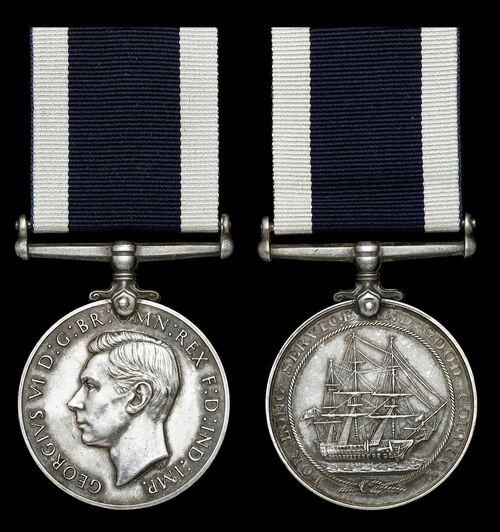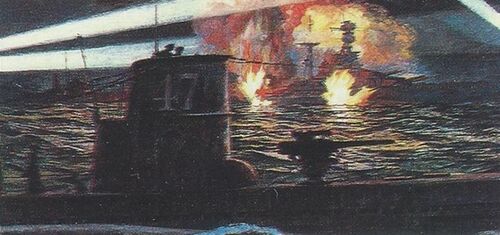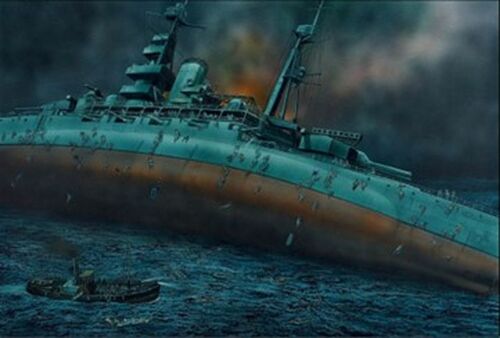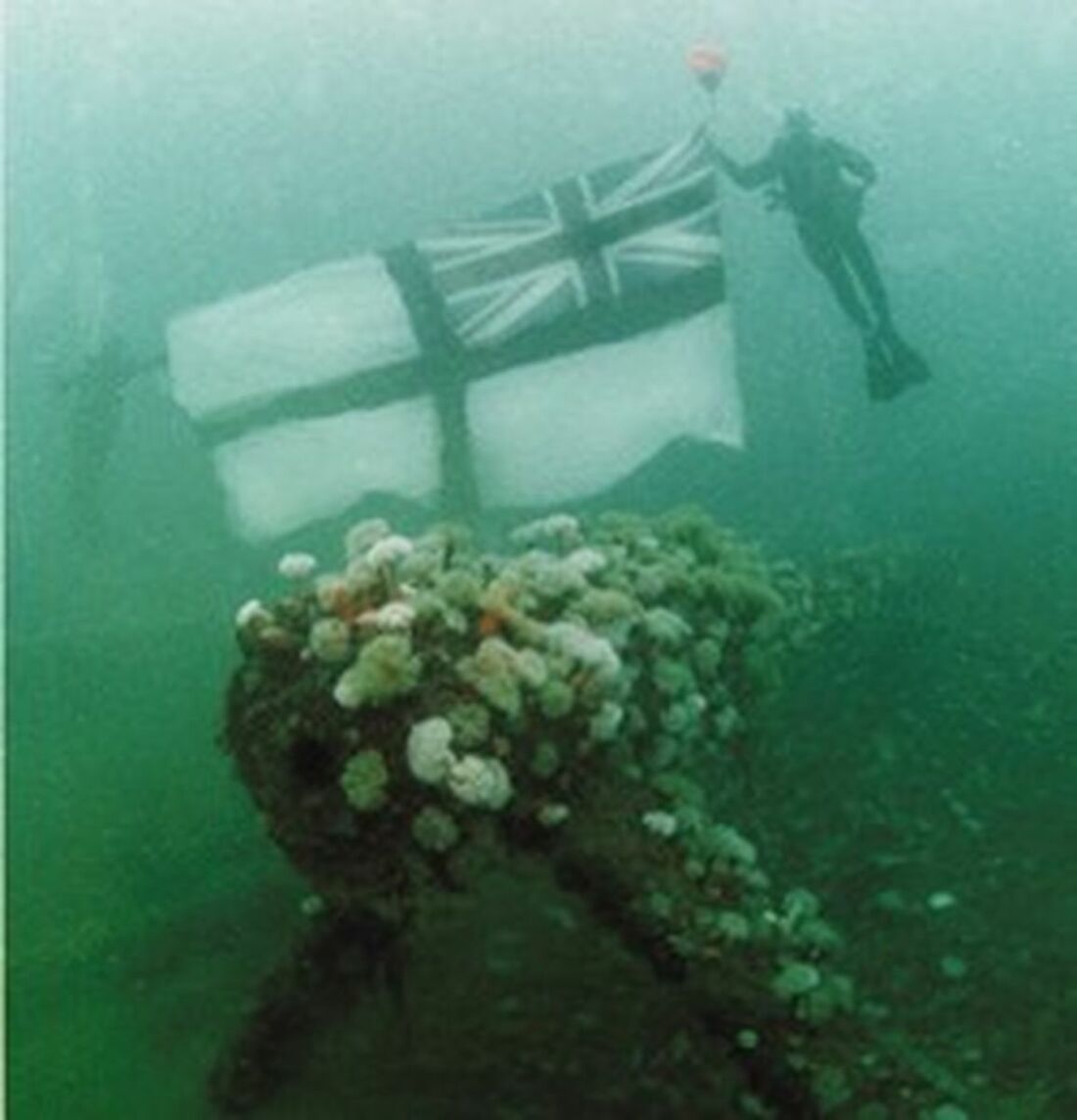Auction: 23113 - Orders, Decorations and Medals - e-Auction
Lot: 621
'Inside of Scapa Flow, the harbour of the English sea force, it was absolutely dead calm in there. The entire bay was alight because of bright northern lights. We then cruised in the bay for approximately one and a half hours, chose our targets, fired our torpedoes. In the next moment there was a bang and the next moment the Royal Oak blew up. The view was indescribable. And we sneaked out, in a similar fashion as we got in, close past the enemy guards, and they did not see us. You can imagine the excitement and happiness we all felt, about the fact that we managed to fulfil our task and achieve such a huge victory for Germany.'
Günther Prien, Captain of the U-47, summarises his momentous foray into Scapa Flow on the night of 14 October 1939
The Royal Navy L.S. & G.C. Medal awarded to Chief Petty Officer A. Harmer Navy, who was among those fortunate to survive the loss of the battleship H.M.S. Royal Oak when she was torpedoed and sunk by the U-47 at Scapa Flow on the night of 14-15 October 1939
Royal Navy L.S. & G.C., G.VI.R., 1st issue (J.111268 A. Harmer. P.O., H.M.S. Ramillies), minor official correction to surname, good very fine
Alfred Harmer was born at Battle, Sussex on 6 January 1909 and entered the Royal Navy as Boy 2nd Class in August 1924.
In June 1939, he joined the battleship H.M.S. Royal Oak as an Acting Leading Seaman and, as cited above, he was likewise employed at the time of her loss on the night of 14-15 October 1939.
Loss of the "Royal Oak"
A summary of Royal Oak's loss appears on the 'Scapa Flow Wrecks' website, from which the following extract has been taken:
'The German submarine U-47, under the command of Günther Prien, approached Scapa Flow through the narrow approaches at Kirk Sound with surprising ease. It was high tide and a little after midnight on 14 October 1939. U-47 first sailed towards Lyness but, finding no ships in the area and encountering no resistance, then turned to the north where H.M.S. Royal Oak, H.M.S. Pegasus and possibly H.M.S. Iron Duke were spotted. A total of 51 ships were in Scapa Flow at the time, 18 of which can be described as fighting ships.
When the first torpedo struck the Royal Oak at 12.58 a.m., the dull thud confused the sailors - they thought the muffled explosions were an on-board problem, perhaps an explosion in the paint store. They certainly did not think it was a U-boat attack. A second salvo failed to deliver a hit but the confusion surrounding the first hit gave Günther Prien an additional 20 minutes to return to his firing position, reload, and fire a third salvo. This third discharge landed direct hits amidships.
Such was the ferocity of the explosions, the ship heeled over alarmingly and all the lights went out. It had been fine weather so all of the ship's hatches were open. Undoubtedly Royal Oak would have taken longer to sink and more lives would have been saved if the watertight hatches had been closed; but it is not normal procedure to have all hatches closed when in a supposedly safe harbour with no alerts.
When the ship rolled its gun barrels shifted, pulling the ship faster beneath the surface. Water crashed through the open hatches and men asleep in their bunks were unable to get out in time. It took just minutes for the battleship to sink. Hundreds fought for their lives in the water, trying to swim for shore through thick fuel oil and in freezing temperatures. A total of 834 men lost their lives, some of whom were buried in the Lyness Royal Naval Cemetery on Hoy.'
Fortunate to be among the survivors, Harmer returned to sea in the destroyer Havelock in the period February 1940 to March 1941, when she saw action off Norway, followed by extensive service in the battleship Ramillies in the period August 1941 to March 1944, when, among other operations, he participated in the battle of Madagascar in May 1942. On that occasion, Ramillies was attacked and hit by a Japanese midget submarine, the explosion tearing a large hole in her hull and causing extensive flooding. Listing badly and reduced to a speed of less than 10 knots, she limped to safety at Durban.
Harmer, who was awarded his L.S. & G.C. Medal in November 1941, ended the war with an appointment was at the gunnery training establishment Excellent and he was released 'Class A' as a Chief Petty Officer in March 1949.
Postscript
Prien did not survive the war: he and U-47 were lost on 7 March 1941, possibly as a result of an attack by the destroyer H.M.S. Wolverine. News of the loss was kept secret by the Nazi government for ten weeks. Several of U-47's crew from the Royal Oak mission survived, having been transferred to other vessels. Some of them subsequently met with their former enemies from Royal Oak and forged friendships with them.
Royal Oak's loss is commemorated in an annual ceremony in which Royal Navy divers place the White Ensign underwater at her stern.
A memorial at St. Magnus Cathedral in nearby Kirkwall displays a plaque dedicated to those who lost their lives, beneath which a book of remembrance lists their names. This list of names was not released by the Government until 40 years after the sinking. Each week a page of the book is turned. The ship's bell was recovered in the 1970s and, after being restored, was added to the memorial in St. Magnus.
The H.M.S. Royal Oak Association holds an Act of Remembrance annually at Portsmouth, the Royal Oak's home port, on the Saturday nearest to 13 October; originally at the Naval Memorial at Southsea, but in later years at St. Ann's Church, Portsmouth Naval Base. At the service on 9 October 2019, eighty years after the sinking, a memorial stone was unveiled in the church by Anne, Princess Royal, the Commodore-in-Chief of H.M.N.B. Portsmouth. Some 150 relatives and descendants of the crew were in attendance.
Despite the relatively shallow water in which she sank, most of bodies could not be recovered from Royal Oak. Marked by a buoy, the wreck has been designated a war grave and all diving or other unauthorised forms of exploration are prohibited under the Protection of Military Remains Act 1986. In clear water conditions, the upturned hull can be seen reaching to within 5m. of the surface.
The brass letters that formed Royal Oak's name were removed as a keepsake by a recreational diver in the 1970s. They were returned almost twenty years later, and are now displayed in the Scapa Flow visitor centre in Lyness.
For a moving documentary on the loss of the Royal Oak, see:
https://www.youtube.com/watch?v=NpTQaf-5IxY&t=178s
Subject to 20% VAT on Buyer’s Premium. For more information please view Terms and Conditions for Buyers.
Sold for
£220
Starting price
£70











